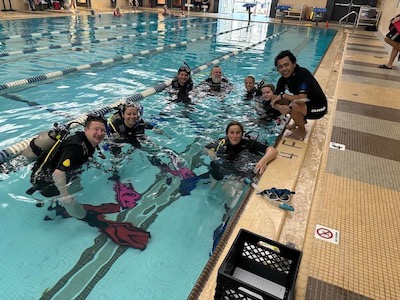What to Expect in Your Open Water Certification Class

Most Open Water classes follow the same basic standards, but the agency and instructor still matter. Here is how to think about PADI vs SSI vs SDI before you enroll.
Scuba certification begins with your Open Water course. This is where you learn the theory, safety habits, and in-water skills that make every dive possible. Whether you choose an online format or a full classroom experience, the goal is the same. To build real confidence before you enter open water.
How the Academic Training Works
Your first lessons focus on how diving affects the body, how your equipment functions, and what can go wrong if used carelessly. You’ll learn about pressure, buoyancy, dive planning, and the physics that govern your time at depth. Most agencies now offer online learning you can complete at your own pace, followed by short classroom reviews. The concepts are serious, but the method is straightforward and the more relaxed you are, the easier it is to absorb.
Course Logistics and Requirements
Before any in-water training, you’ll complete a basic swim and float test to show comfort in the water. Expect to swim about 200 yards by any stroke and float or tread for 10 minutes. Courses typically take 3–4 days across academics, pool work, and four open-water dives. You’ll need your own mask, snorkel, and fins, while tanks, weights, BCD and regulators are provided or rented. For guidance on choosing where to train, see How to Choose a Dive Shop and Instructor.

Pool and Confined Water Training
This is where you put on scuba gear for the first time and breathe underwater. You’ll practice equipment setup, regulator clearing, mask skills, buoyancy, air sharing, and emergency procedures. Everyone finds one skill harder than the rest, be it mask removal, hovering, or equalization. But repetition builds comfort. Pool sessions may be spread over several evenings or packed into a weekend. The goal is to move smoothly and stay calm, not to be perfect on the first try.
Your Open Water Dives
Open water dives take place in a lake, quarry, or ocean where you apply what you learned under real conditions. You’ll descend along a line, check buoyancy, repeat safety drills, and begin swimming freely. Expect four dives total, often two per day across a weekend, with depths around twenty to forty feet and each dive lasting thirty to forty minutes. The final portion of each dive is usually unstructured time for exploring when you stop feeling like a student and start feeling like a diver.
What the Certification Means
Passing your evaluations earns an Open Water Certification. It allows you to dive with a buddy, rent equipment, and join most recreational trips. Certification shows you can handle yourself without close supervision, but experience only comes with practice. Think of it as reaching the trailhead. You’ve learned how to read the map and pack your gear, but the journey ahead still requires awareness and humility.
If You Feel Nervous About Diving
Feeling nervous is normal. Breathing underwater is unlike anything else, and everyone adjusts differently. A few ways to make it easier:
- Take it slow – Repeat any skill until it feels natural.
- Speak up – Let your instructor know if something feels off.
- Practice calm breathing – Smooth, steady breathing helps you relax.
- Spend more time in the water – Swimming or snorkeling beforehand builds comfort.
- Accept mistakes – Every diver fumbles early skills. Progress matters more than perfection.
Final Thoughts from Experience
Your Open Water course sets the tone for everything that follows. With quality instruction and deliberate practice, you’ll enjoy every dive that comes after. Focus on buoyancy and trim; they define comfort and control underwater. For a deeper look at what this stage of diving teaches, both technically and mentally, see the chapter “Your Open Water Class” in my book The First Breath, part of The Recreational Diver’s Journey series.